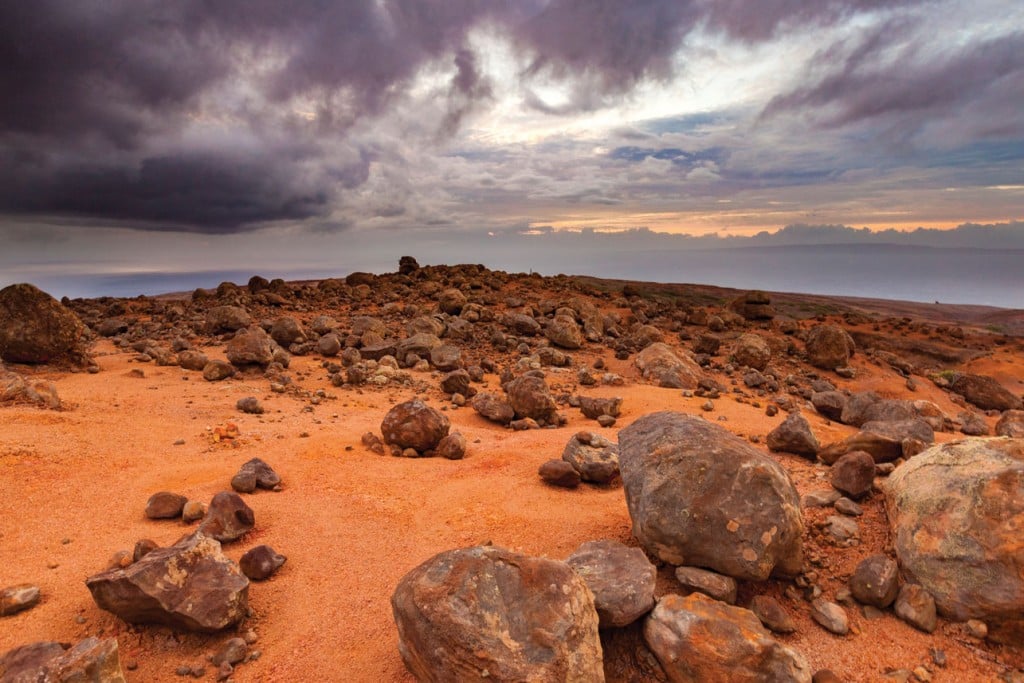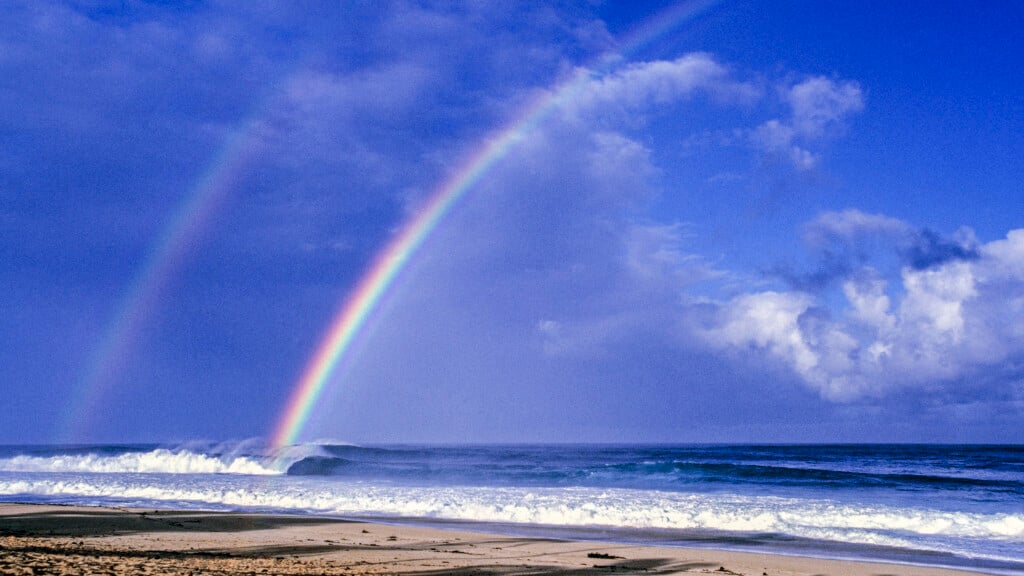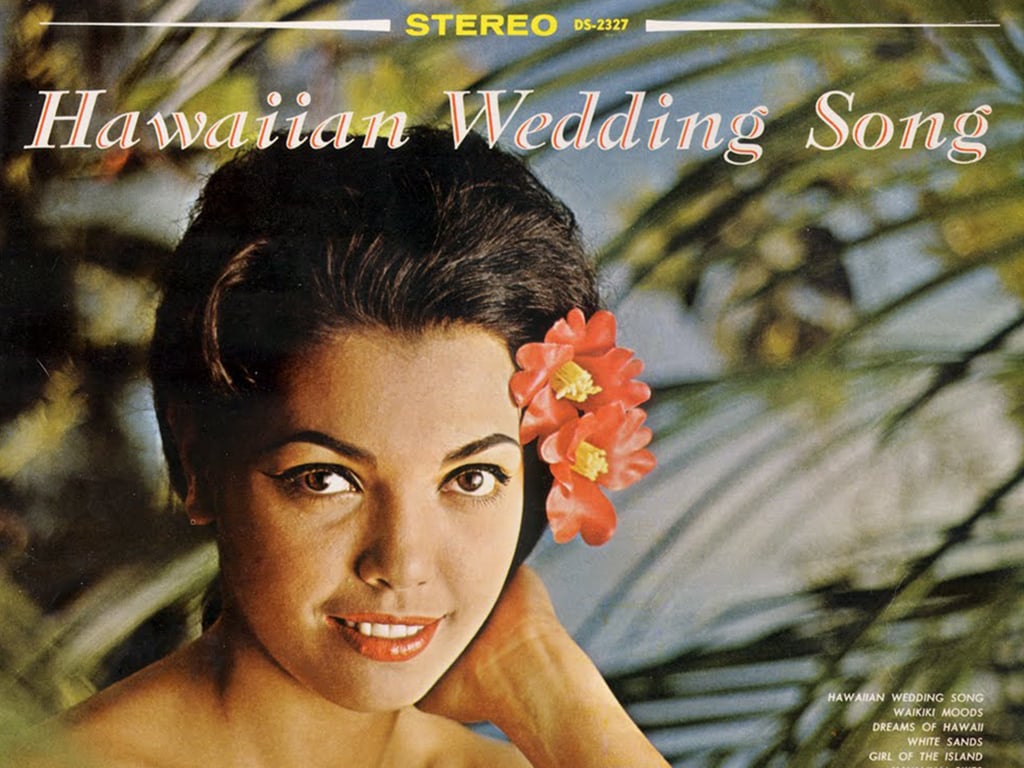Keahiakawelo, Lanai’s legendary ‘Garden of the Gods’
The stark Lanai landscape is full of Hawaiian history and lore.

The sun is falling quickly in the sky, surrounded by a hazy, brilliant vog-induced glow, and the red dirt at my feet is turning the rich, red-orange color of fire.
An elevation of around 1,600 feet may not sound remarkable, but standing at the edge of Lanai’s western uplands of Keahiakawelo, it feels as though I’m on top of the world.
A countless number of boulders, some as tall as six feet, fill the area of land around me, which many describe as a lunar landscape, vacant of trees, shrubs, flowers or grass. The clouds are on the same level plane as I am, the western seacoast of Lanai is laid out sloping downward before me and the island of Molokai can easily be seen across the Kalohi Channel.
It’s my first visit to the island, and I had only arrived a couple of hours before, right off the ferry from Maui. Much of the island’s roads are unpaved and rugged, but even with that said, maneuvering my four-wheel-drive Jeep up and down its uneven surface has been exciting and a bit comical. Arriving to Keahiakawelo, I was not surprised to see there isn’t anyone else around—I only passed a couple cars before turning off the main road.
When Alexander Hume Ford visited this site in 1912 for Mid Pacific Magazine, he compared it to Garden of the Gods in Colorado, a nickname that grew in popularity over time, but has no relationship to Lanai’s cultural history. Its traditional name, Keahiakawelo, however, represents a meaningful history, directly tied to the health and well-being of the people who lived here. The place is what Hawaiians call a wahi pana, or sacred storied landscape.
“The priest of Molokai, named Lanikaula, had become angry at the people of Lanai, so he lit a fire and began offering prayers of ill will to the livestock and its people. The priest of Lanai, Kawelo, discerned what had happened and he lit a fire himself, warding off the prayers and pushing them back to Molokai. Thus ke ahi (the fire) a (made by) Kawelo,” began Kepa Maly, who I had met with earlier at the Four Seasons Resort Lanai. Listening to him speak, I became a child locked in a fairy tale, waiting to hear what happened next.
Maly was raised on the island and has almost 40 years of experience doing ethnographic historical studies across Hawaii. He’s also the senior vice president of culture and preservation for Pulama Lanai—Lanai owner Larry Ellison’s land-stewardship company—and helped form the Lanai Culture and Heritage Center, where he continues to volunteer full time.
“The priests are evenly matched, but Kawelo learns a secret: Personal things, like fingernails, hair, used soil, kapa or even excrement, can be gathered up and used as bait to kill somebody through a spirit,” continues Maly. “In modern context, we would call it sorcery. So Kawelo finds where Lanikaula is hiding these things, and, under the cover of dark, takes his canoe and climbs up little Mokuhooniki, which is a small island off the eastern tip of Molokai.”
The story, as you would expect, ends in Kawelo’s favor. He returns to Lanai to this place, now called Keahiakawelo, and lights his fire with what he had gathered of Lanikaula’s. “The Molokai priest, seeing what Kawelo has done [from across the Channel], calls out in Hawaiian, ‘Alas, I died,’ and falls dead to the ground. The people of Lanai were saved.”

Today it’s bare and desolate.
Photo: Grant Kaye
The whipping winds surprise me as I take in the view of Molokai and imagine the priests’ fires, expelling smoke above these two islands. I soon find I’m dressed inappropriately for this excursion in a tank top and shorts, having rushed here to watch the sunset. The winds are so strong, they even have a native name, “hoo moe pili” (to cause the pili grass to lie down), and it’s making me cling to my arms for warmth. I walk past the many tall boulders moving with the shadows, and feel the hardpan earth, a dense clay, solid beneath my feet. Loose dirt that breaks away is flung into the air and taken out to sea—wind erosion by definition.
But it wasn’t always this way.
“It was a low forest with what are now rare natives—lama (Hawaiian ebony), gardenia, olopua, naio, alaa, keahi, maile (a native twining shrub) … and on,” said Maly. “The trees were likely not much more than 30 feet high, lower in the wind-buffeted fronts of the forest.”
The ohia lehua flower, known for its bright red, pink, yellow and red varieties across the Islands, had a purple blossom unique to only Lanai. Now extinct, they’re fondly referred to as the po (purple) lehua, and were connected to Keahiakawelo’s legend: The wind blowing the black smoke from the fire of Kawelo turned the lehua forest of flowers nearby into purple-blossomed lehua. Now immortalized in this legend, the pigment of these flowers is left to the imagination for most people and memories passed down for others.
“The tutu (grandparents) that helped raise me while I was growing up, they were born around 1890. Right around 1900 to 1905, the last of the purple po lehua were being consumed by goats,” said Maly. “So they saw them when they were children, but they were destroyed. There was no control.”

Photo: Matthew Dekneef
Following Western contact, goats and sheep were introduced to the island in the 1800s, and then followed by axis deer and antelope. The grazing animals wildly outnumbered the human population, with some estimates of up to 100,000, and the environment of Lanai suffered. The land was stripped of much of its vegetation, native plants became extinct and the extensive erosion took its toll.
Sad to hear what has become of Keahiakawelo, but glad to know that its stories are continued to be told, I take my final photos of the remarkable storied landscape as the wind speeds up, awakening like a nocturnal being. I rush to my Jeep to get away from the cold, and head back to Lanai City with a clear view in the rearview mirror of the fiery light of the sun sinking below the horizon behind me.
Download the Lanai Culture and Heritage Center’s “Lanai Guide” GPS-enabled mobile app or visit lanaiguideapp.com for helpful directions and information.


